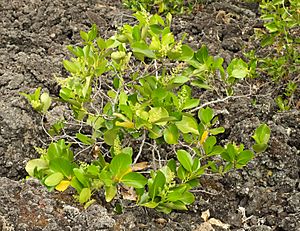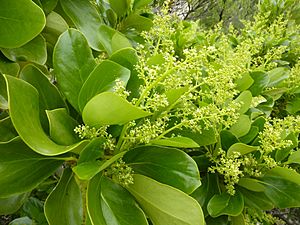Shining broadleaf facts for kids
Quick facts for kids Shining broadleaf |
|
|---|---|
 |
|
| Scientific classification | |
| Genus: |
Griselinia
|
| Species: |
lucida
|
Griselinia lucida, often called puka, akapuka, or shining broadleaf, is a special plant from New Zealand. It's an epiphyte, which means it grows on other plants or trees, not in the ground. Puka is usually found in wet forests and along the coast, mainly in New Zealand's North Island. You can also find it in some parts of the South Island.
This plant has big, shiny, dark-green leaves that aren't perfectly even on both sides. One cool thing about puka is its roots. They grow down from the host tree, looking like flutes, all the way to the ground.
Contents
About the Puka Plant
The puka tree can grow quite tall, reaching up to 10 to 15 metres high. Its branches are rough and not very long. They can grow to about 1.5 metres wide.
Leaves and Flowers
The leaves of the puka are thick, glossy, and a yellowish-green color. They are usually 5 to 12 cm long and 4 to 5 cm wide. A unique feature is that one side of the leaf base is often a bit longer than the other. The leaves grow in an alternating pattern along the stem.
Puka has small, greenish flowers that grow on thin twigs. These flowers appear from late spring to mid-summer. The female flowers have five petals, while the male flowers have small greenish petals.
Fruits and Berries
After the flowers, the puka produces dark purple or black berries. These berries are about 6 to 7 mm long. They start to appear in mid-summer and become ripe from autumn through winter.
Where Puka Grows
You can find puka all over the North Island of New Zealand. In the South Island, it grows as far south as North Canterbury on the east side and South Westland on the west side. It lives in many places, from low-lying areas to high hills, forests, and shrub lands.
Interestingly, puka is more common in the South Island than in the North Island. In the North Island, it tends to grow at higher elevations compared to its growth in the South Island.
Puka's Favorite Places
This plant is very adaptable and can grow in many different environments. In places with lots of moisture, puka often grows as an epiphyte. This means its roots hang down from other trees to soak up water and nutrients. Puka is also often planted to create screens or hedges because it can stand up to strong winds and tough conditions.
Puka's Life Cycle
Plants like puka go through different stages as they grow in a forest.
- Gap phase: This is when an opening appears in the forest canopy, like when an old tree falls. This space is ready for new plants to start growing.
- Building phase: During this time, a young puka seedling grows bigger and reaches the main canopy of the forest.
- Mature phase: This is when the puka tree is fully grown, and its top part (the canopy) is complete and stable.
Puka grows faster during the building phase than in other stages. Its trunk grows thicker more quickly when it's young and reaching for the sunlight. When it's fully grown, it still grows, but more slowly. On average, puka and other similar trees grow about 15 cm taller each year.
Flowers and Reproduction
The puka flowers are quite small, only about 4 to 6 mm across. The male and female flowers grow on separate trees. This means you need both a male and a female puka tree for seeds to be made. Pollen, which is like plant dust, is carried from the male flowers to the female flowers by wind and insects.
Berries and Seeds
The fruits of the puka stay green for a while. As they get ready to ripen, they turn dark purple or black. Once they are ripe, they fall to the ground. These berries are 6 to 7 mm long. They appear in mid-summer and are fully ripe from autumn to winter.


